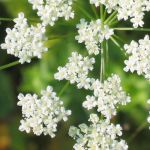| Common Name: |
Burnet Saxifrage |
| Other Names: |
Small Pimpernel |
| Botanical Name: |
Pimpinella saxifraga |
| Genus: |
Pimpinella |
| Family: |
Apiaceae |
| Native Location: |
Europe |
| Cultivation: |
Rich, well-drained, sandy soil, pH6.0-7.5, in sun P. anisum. Dry, alkaline soil in sun or light shade (P. saxifraga). Pimpinella anisum is recommended in companion planting to repel aphids and cabbage worms; the flowers attract parasitic wasps, which prey on a number of garden pests. |
| Propagation: |
By seed sown when ripe. Prick out seedlings into deep containers to allow development of tap roots. |
| Harvest: |
Plants and leaves are cut in summer and used fresh; roots are lifted in autumn and dried for use in decoctions or distilled for oil (P. saxifraga). Seeds are collected as they ripen and distilled for oil, or dried for use whole, ground, or distilled in water, infusions, and spirits (P. anisum). |
| Height: |
90cm (36in) |
| Width: |
30-75cm (12-30in) |
| Hardiness: |
Z6-8 |
| Warning: |
All white-flowered umbellifers (members of the family Apiaceae) must be accurately identified before use, because many look alike and a number are extremely poisonous. |
| Parts Used: |
Whole Plants, leaves, roots, oil |
| Properties: |
A bitter, pungent, diuretic herb that is expectorant, improves digestion, relieves spasms, and increases lactation. It is antiseptic and promotes healing. |
| Medicinal Uses: |
Internally for infections of the throat and upper respiratory tract, mucus, measles, heartburn, cystitis, urinary stones, gout, and insufficient lactation. Externally for sore throat, inflamed gums, and wounds. |
| Culinary Uses: |
Cucumber-flavored young leaves are added to salads and as a garnish for summer drinks. Traditionally, bundles of young shoots were suspended in casks or beer and wine to improve flavor. |
| Economic Uses: |
Oil gives a bitter flavor to liqueurs and pharmaceutical products. |
| Bibliography: |
The Encyclopedia of Herbs by Deni Bown Copyright © 1995, 2001 Dorling Kindersley Limited pg. 317-318 |

